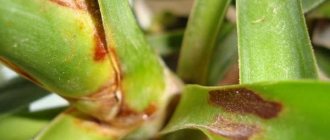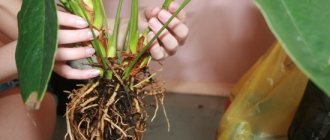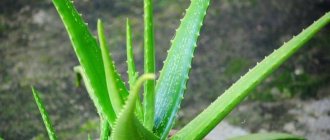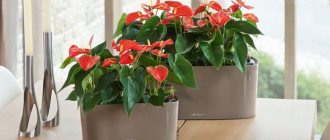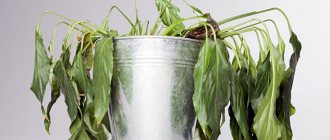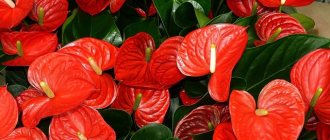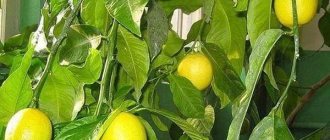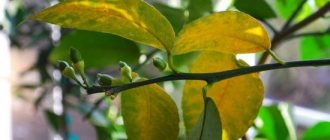Anthurium or Male Happiness is a plant with green heart-shaped leaves and flowers of red, white, pink, orange or even green. “Male Happiness” looks very beautiful and impressive, which is why it is loved by many flower growers. In order for its beauty to be preserved for many years, you need to know how to care for an indoor anthurium in a pot and why the flower’s leaves dry out, turn yellow, turn black, or it does not bloom. Once you find out the reason, you will immediately understand what to do to eliminate, or better yet, avoid problems when growing a plant at home.
Brown dry spots on anthurium
If the anthurium is sick. Brown spots on leaves
Many fans of indoor plants have anthurium in their home collection. It is valued for its unusually beautiful flowers and wide shiny leaves. The difficulty in caring for anthurium lies in the need to create and maintain optimal conditions under which the plant will develop well and will not be affected by pests and diseases.
Sometimes gardeners begin to notice how brown dry spots appear on the anthurium, which spoils the appearance of the flower. It should be noted that most diseases are associated with non-compliance with plant care rules.
Features of caring for anthurium
Anthurium is a tropical plant, and therefore requires special conditions for cultivation and care. An important point is to choose the right place where the flower will stand, since it loves light, but direct sunlight is harmful to it. When constantly exposed to such lighting, the leaves begin to curl into a tube.
Drafts are also harmful to the flower. The optimal temperature, which is considered comfortable for the plant, is the range between 20 and 25 degrees Celsius. In addition, the soil must be at the same temperature as the air in the room.
Daily spraying of anthurium is recommended, as it prefers high air humidity. At the same time, you need to try to prevent water from getting on the flowers themselves, otherwise stains may appear on them, which will affect their decorative effect.
Water the plant moderately, making sure that the earthen ball does not dry out, but remains slightly moist. Water for irrigation is used warm and well-settled; stagnation is not allowed.
Causes of spots on plant leaves
Since the plant is afraid of drafts, the result of staying in such conditions will be the appearance of large brown spots. You need to move the flower to a warm place and reduce watering to stop their development.
If the diameter of the spots is not large, then most likely this is a consequence of sunburn. Anthurium should be moved to partial shade, where it will be much more comfortable.
If the leaf blades of the anthurium are completely covered with brown dry spots, and the size of the new growing leaves is much larger than the previous ones, then the reason lies in the excessive amount of fertilizer used to feed the plant.
Sometimes the plant is affected by mealybugs. The above-ground parts of the flower provide an excellent environment for their life. This also leads to brown dry spots appearing on the anthurium. If no pest control measures are taken for a long time, the leaves may fall off. A good remedy for mealybugs is treatment with karbofos.
Yellowing and dying of old anthurium leaves located at the bottom of the plant is a natural process. Sometimes adult plants can lose their attractiveness because of this, so flower growers practice flower rejuvenation.
Fungal diseases of anthurium
The most common fungal disease of anthurium is septoria. With it, the leaf plate is covered with brown spots, along the edges of which there is a noticeable border of a light color, and inside there are dark dots.
In this case, the concentration of substances should be weak.
To ensure that the anthurium blooms abundantly and the leaves are shiny and clean without any stains, you need to be careful when feeding the plant. Fertilizers are applied no more than once every fourteen days. Any universal fertilizer is suitable for fertilizing.
Any universal fertilizer is suitable for fertilizing.
The only thing you should pay attention to is during the flowering period of anthurium; here the priority should be special mixtures for decorative flowering plants, such as “Agricola”, “Fertika-lux”, “Pokon” and others. Particular attention must be paid to the dosage of fertilizers; their concentration should be halved from that recommended on the packaging with the drug. Particular attention must be paid to the dosage of fertilizers; their concentration should be halved from that recommended on the packaging with the drug
Please rate the material you read :)
Particular attention must be paid to the dosage of fertilizers; their concentration should be halved from that recommended on the packaging with the drug. Please rate the material you read :). Please rate the material you read :)
Please rate the material you read :)
(7 rated, score: 5.86 out of 10) Loading...
Lack of inflorescences
Often, floriculture lovers complain that the majestic anthurium develops fully, but flowers do not appear on it
There can be many reasons why anthurium does not bloom; it is important to figure out what caused this phenomenon and eliminate the cause. The reason that flowers turn green and inflorescences do not appear is often a lack of lighting
When growing this plant, you should control the light intensity, since this flower reacts equally negatively to both an excess of sunlight and its lack.
What can be done so that flowers can appear? At the time when the yellow anthurium begins to prepare for the formation of flowers, it is necessary to provide it with the maximum amount of lighting. If there is a lack of natural light, an additional artificial lighting source is installed. This is how the plant will bloom and develop.
Indoor anthurium does not bloom due to inappropriate temperature conditions. During the period when the plant is preparing to flower, it can be moved to a heating source. The optimal temperature is 22 degrees above zero. If the temperature is too high, flowers may also not form, so the temperature in the room is reduced.
Popular articles How to care for clivia at home
Another reason why anthurium lacks inflorescences is non-compliance with the soil irrigation regime. Any deviations in watering can cause the flower to lack buds. Another important indicator is air humidity, as well as old dry flowers, which prevent the formation of new inflorescences, so it is recommended to cut off old flowers immediately after they have finished flowering. If the care is correct, the plant will soon delight you with abundant flowering.
Anthurium is a houseplant that even turns yellow beautifully
It is no coincidence that Anthuriums have been holding the lead for a decade in the list of the most fashionable indoor “universal” plants - plants that have equally good leaves and flowering. They look not just highly decorative, but almost flawless.
The dense texture of large leaves and inflorescences with bright spathes, with all the choice of different colored varieties, seem to be a true modern classic. Anthuriums are so often used in the landscaping of restaurants, coffee shops and offices, they are so extolled that the plant has acquired the reputation of a true Spartan. Although the character of anthurium is very far from such status.
Anthuriums are plants that themselves tell their owners what is wrong with them. They usually do not react to slight deviations for a long time, showing signs of loss of decorativeness only with systemic violations of care or in a completely unsuitable microclimate.
The most common symptom of problems with anthuriums is yellowing of the leaves. The sheets may become covered with bright yellow spots, partially turn yellow, as if watercolor is spreading across the plate, or be completely repainted. At the same time, sometimes the cuttings of the anthurium turn yellow, and sometimes they remain green.
Even after being repainted, the leaves of this plant still remain elastic, hard and shiny for quite a long time. Among all indoor plants, it is the anthurium that exhibits the most decorative yellowing. And one of the easiest “treatments”: if you take timely measures, the plant will quickly restore its usual colors, normal development, and flowering.
If measures are taken in a timely manner, the anthurium will quickly restore its usual colors, normal development, and flowering. gardening
How to prevent leaves from drying out
It is much easier to organize suitable conditions for anthurium than to then treat a drying bush. Thus, for the plant to feel comfortable, it is necessary:
- Place the pot on eastern or western window sills in the summer, and move it to the southern ones in winter;
- Water the flower moderately, only after the substrate has dried;
- Organize a high-quality drainage system for water drainage by making holes at the bottom and placing a drainage layer in the pot (1/3 of the total height);
- Avoid direct sunlight on the leaves;
- Spray the bush and wash it regularly;
- Use suitable soil with the required acidity (5.5-6.5 pH).
Timely replanting (once a year) with a change of substrate will help avoid nutrient deficiency and maintain the health of the flower.
What is the name of the flower of male happiness, what does it look like?
The flamingo flower fits perfectly into the modern interior of a home or office, emphasizing its laconicism and harmonious atmosphere.
Florists often use anthurium in flower arrangements because cut flowers can stay fresh for up to five weeks.
Anthurium can bloom all year long
A plant with bright flames, which form an inflorescence-cob, with velvety dark green leaves. An arrow-shaped or heart-shaped bract, like a blanket, wraps the cob. The plant can reach 40 cm in height
With bright scarlet stipule color
What is an anthurium inflorescence? It is a spadix surrounded by a showy shiny bract that is pink, brown, white spotted, yellow or fiery red.
With purple stipule
White anthurium inflorescence
Brown
Pink stipule with green edge
Anthurium blooms in March and can delight with flowering for 7-8 months. Each individual inflorescence blooms for 1-1.5 months.
Only in good conditions does an exotic plant grow up to 0.8 m in height. Anthurium can reach 0.5 m in diameter
Only a healthy and well-groomed plant will help solve problems in your personal life.
In the American tropics and subtropics, anthurium grows in the wild and is an epiphyte (attached to other plants). But in our weather conditions, the flamingo flower will feel comfortable only in heated rooms. An elegant flower requires special care
Anthurium in the wild
Brown dry spots on anthurium
If the anthurium is sick. Brown spots on leaves
Many fans of indoor plants have anthurium in their home collection. It is valued for its unusually beautiful flowers and wide shiny leaves. The difficulty in caring for anthurium lies in the need to create and maintain optimal conditions under which the plant will develop well and will not be affected by pests and diseases.
Sometimes gardeners begin to notice how brown dry spots appear on the anthurium, which spoils the appearance of the flower. It should be noted that most diseases are associated with non-compliance with plant care rules.
Features of caring for anthurium
Anthurium is a tropical plant, and therefore requires special conditions for cultivation and care. An important point is to choose the right place where the flower will stand, since it loves light, but direct sunlight is harmful to it. When constantly exposed to such lighting, the leaves begin to curl into a tube.
Drafts are also harmful to the flower. The optimal temperature, which is considered comfortable for the plant, is the range between 20 and 25 degrees Celsius. In addition, the soil must be at the same temperature as the air in the room.
Daily spraying of anthurium is recommended, as it prefers high air humidity. At the same time, you need to try to prevent water from getting on the flowers themselves, otherwise stains may appear on them, which will affect their decorative effect.
Water the plant moderately, making sure that the earthen ball does not dry out, but remains slightly moist. Water for irrigation is used warm and well-settled; stagnation is not allowed.
Causes of spots on plant leaves
Since the plant is afraid of drafts, the result of staying in such conditions will be the appearance of large brown spots. You need to move the flower to a warm place and reduce watering to stop their development.
If the diameter of the spots is not large, then most likely this is a consequence of sunburn. Anthurium should be moved to partial shade, where it will be much more comfortable.
If the leaf blades of the anthurium are completely covered with brown dry spots, and the size of the new growing leaves is much larger than the previous ones, then the reason lies in the excessive amount of fertilizer used to feed the plant.
Sometimes the plant is affected by mealybugs. The above-ground parts of the flower provide an excellent environment for their life. This also leads to brown dry spots appearing on the anthurium. If no pest control measures are taken for a long time, the leaves may fall off. A good remedy for mealybugs is treatment with karbofos.
Yellowing and dying of old anthurium leaves located at the bottom of the plant is a natural process. Sometimes adult plants can lose their attractiveness because of this, so flower growers practice flower rejuvenation.
Fungal diseases of anthurium
The most common fungal disease of anthurium is septoria. With it, the leaf plate is covered with brown spots, along the edges of which there is a noticeable border of a light color, and inside there are dark dots.
In this case, the concentration of substances should be weak.
To ensure that the anthurium blooms abundantly and the leaves are shiny and clean without any stains, you need to be careful when feeding the plant. Fertilizers are applied no more than once every fourteen days
Any universal fertilizer is suitable for fertilizing.
Any universal fertilizer is suitable for fertilizing.
The only thing you should pay attention to is during the flowering period of anthurium; here the priority should be special mixtures for decorative flowering plants, such as “Agricola”, “Fertika-lux”, “Pokon” and others. Particular attention must be paid to the dosage of fertilizers; their concentration should be halved from that recommended on the packaging with the drug
Particular attention must be paid to the dosage of fertilizers; their concentration should be halved from that recommended on the packaging with the drug
Please rate the material you read :)
Particular attention must be paid to the dosage of fertilizers; their concentration should be halved from that recommended on the packaging with the drug. Please rate the material you read :)
Please rate the material you read :)
Please rate the material you read :)
(7 rated, score: 5.86 out of 10) Loading...
Pests
Why do Chinese rose leaves or hibiscus disease turn yellow?
Indoor anthurium, in addition to diseases, can dry out or rot under the influence of insects: aphids, thrips, spider mites, scale insects or whiteflies. If pests appear, you will need a soap solution or insecticide; you will have to treat the crop once every 2-3 days.
Aphid
It is easy to recognize that anthurium is infested with aphids by yellow, curled leaves, sticky secretions, and the plant begins to quickly die. The simplest pest control measure is a warm shower or spraying the plant with a soap solution (20 g of laundry soap per 6 liters of warm water). A more effective solution would be to use drugs: “Antitlin”, “Aktara”, “Aktellik”.
Aphids on anthurium
Thrips
Leaves affected by thrips are covered with light yellow spots of various parameters and shapes. The parasites are located at the bottom of the leaves and are distinguished by a brown tint. The danger of thrips is achieved by the spread of the rust virus. The optimal environment for unwanted guests is high humidity and temperature. It is necessary to adjust the indoor climate. Highly toxic drugs will help treat a flower affected by thrips: Tanrek, Actellik or Fufanon.
Spider mite
Spider mites are identified by small yellow specks on the outside of leaves that merge into huge spots. A cobweb appears at the bottom of the leaf, full of small insects. Ticks love high temperatures and dry air. As soon as the flower turns yellow, it is important to immediately treat the leaves with soapy water, clean them of insects and wipe them with mineral oil. Adjust humidity and temperature conditions.
Shchitovka
Whitish or golden-brown tubercles on anthurium leaves are the first signs of a scale insect sucking out the vital juices of a home flower. An ordinary needle will allow you to remove the pest from the leaf. Single specimens are also cleaned with a toothbrush and wiped with a cotton swab soaked in kerosene - the scale insect will suffocate under the kerosene film.
On a note! Often, gardeners experiment with an oil-based spray to polish anthurium leaves. If parasites are actively multiplying, you should make an insecticidal solution and prepare mineral oils for treating greens.
Whitefly
The flower looks depressed, the leaves curl and become discolored, the buds and flowers fall off. It is worth carefully examining your pet, especially the underside of the leaves. Perhaps the plant has become a haven for insect pests - whiteflies. Small moths with many larvae suck out the vital juices of the anthurium. The consistency of whitefly secretions on the upper part of the leaf resembles a sticky shiny coating, similar to sugary stains. When whiteflies appear, experts advise resorting to the use of chemicals: “Aktara”, “Confidor”, “Akarin”, “Iskra”, “Fitoverm”, “Aktellik”, “Tanrek”.
Whitefly on a healthy plant
Brown spots on anthurium leaves: why they appear and how to get rid of them
A plant called anthurium is known to almost all gardeners. Due to the beautiful combination of green leaves and red flowers of the original shape, it is often called the flamingo flower. This is one of my favorite "pets" that does not require much care or attention. But recently I began to notice that brown spots began to appear on the plant's usually smooth and bright leaves.
I didn’t want to lose such beauty, and I immediately began to look for the cause of the problem, which I succeeded in quite quickly. If you had to face a similar situation, I will tell you how to save a flower from death and return it to its original appearance.
Rot of the stem and root system
In this case, the plant begins to quickly wither; dark depressed spots appear on the basal part of the stem and on the surface of the roots, which are covered with a dense white coating. It's a fungus. Such mold may begin to appear on the leaves. Important: the disease is contagious and can spread to other plants.
What to do: remove from the pot, remove all areas affected by rot, treat the roots with a solution of potassium permanganate and a fungicide (phytocide, phytodoctor), completely replace the soil in the pot, having previously disinfected the pot itself.
Lack or excess of nutrition
If the anthurium suddenly stops growing and its leaves dry out or turn yellow, this may be due to a nutrient deficiency. Lack or absence of phosphorus, potassium, nitrogen, magnesium and other elements will cause the plant to turn brown.
Special ready-made liquid products are used as fertilizers. Thanks to their effect, the diseased anthurium will restore its healthy and blooming appearance. These medications should be used weekly. As soon as the plant acquires its former strength, mineral fertilizing is applied once every 14 days.
However, not only a deficiency, but also an excess of fertilizers can be the reason why anthurium leaves dry out. In this case, the root system must be washed in warm water and treated with a disinfectant, and then the plant must be transplanted into a pot with new soil.
Non-communicable diseases
Chlorosis
Petunia diseases - why do the leaves turn yellow?
If yellow spots are visible on green foliage in bright light, the crop suffers from poor nutrition (lack of magnesium and iron). It is important to take care of regularly feeding the plant with fertilizers for decorative flowers.
Smallpox
Yellow-green bumps and ring-shaped yellowing are a consequence of low temperature combined with high humidity. If you forget about regularly feeding the anthurium, the plant will not have the strength to resist smallpox, and it will take a long time to revive the culture.
Enatsii
When a flower is infected with enation, uneven curvature of the leaves, an ugly and humpbacked appearance are visible, and the anthurium may turn black. The disease progresses in cold rooms with drafts and sudden changes in dry and humid air.
Why do anthurium leaves dry out?
Many people complain that the beautiful leaves of the flower dry out, which makes the plant look ugly. There may be several reasons for this:
- insufficient watering;
- dry indoor air;
- draft;
- aphid damage;
- development of anthracosis or other diseases.
The flower pot must be placed in a warm place without drafts. If the room is hot, then watering should be plentiful. In cool rooms, the plant is watered less frequently. It is necessary to water only when the soil dries 1/3 of the pot.
The fact that a flower is infected with greenhouse aphids is indicated by wrinkled and curling leaves with light spots. The pest should be controlled with special chemicals. It could be "Karbofos" or "Aktelik".
Signs of actactosis are leaves drying out from the edges, which eventually become wasted and dry out completely. Treatment with systemic fungicides will help the flower recover.
Anthracnose
This is another dangerous disease caused by Colletorichum fungi. What are the signs of a disease affecting anthurium? The leaves, petioles and stems dry out, the entire plant is quickly affected by spores and may die within a month. Most of the flower can be saved if treatment is started after the first symptoms appear. First, brown spots appear, on which dark spores are visible up close. Over time, the small patchy areas enlarge to become a solid dry area. Anthracose flows especially rapidly in a greenhouse atmosphere, that is, with high humidity and heat. The danger is that the fungus spreads to healthy areas with water when watering and spraying.
If anthurium has been exposed to disease, treatment should be as follows:
- reduce watering or not water at all for 1-2 weeks;
- add special products to the water for spraying (copper oxychloride solution or copper sulfate 100 g per 2 liters of water);
- trim off all leaves with brown spots;
- if necessary, it is necessary to treat the soil with disinfectants (Abiga-Pik at 5 g per 1 l);
- if the flower is seriously damaged and treatment is unsuccessful, it must be burned, since there is a high probability of anthracosis spreading to other plants.
